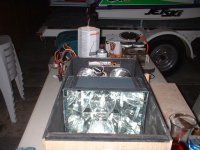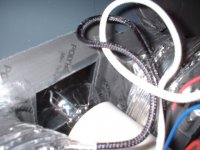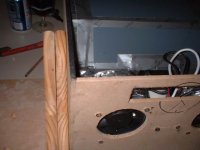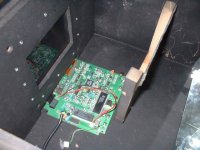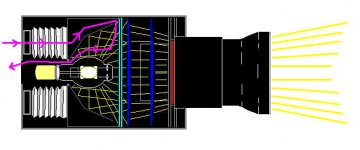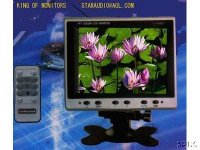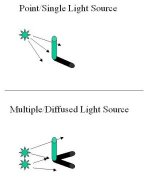this is what i got so far. its been lagging
this is what i got so far. ive been waiting for my low-e glass for ever. but the guy end up hooking it up with 1/8" low-e glass just till my 1/4" comes in. there you'll see my box mirror reflector and maybe alittle of the cooling sys. . if you look at the left and right side of thereflector you'll see 4 rectangle holes, thats for the cooling system.i got more pictures but i only no how to put one at a time.
this is what i got so far. ive been waiting for my low-e glass for ever. but the guy end up hooking it up with 1/8" low-e glass just till my 1/4" comes in. there you'll see my box mirror reflector and maybe alittle of the cooling sys. . if you look at the left and right side of thereflector you'll see 4 rectangle holes, thats for the cooling system.i got more pictures but i only no how to put one at a time.
Attachments
this is my f*$ked up lcd between the two boards and my controler chip,the box is to go over the chip to keep it cool..
if you got ?'s ill answer them later cause im working right now. but go ahead and post your ?'s.this area of my box is going to soon have 2 fresnels and the low-e glass by the reflector. each layer of fresnel and glass is gonna sepparrate the box of insulation and heat provention reasons.
if you got ?'s ill answer them later cause im working right now. but go ahead and post your ?'s.this area of my box is going to soon have 2 fresnels and the low-e glass by the reflector. each layer of fresnel and glass is gonna sepparrate the box of insulation and heat provention reasons.
Attachments
hehe
NAH!!! I do not wanna sell my system. i am pretty much satisfied with it for the money. And if i did want to sell it, there is no point to hide behind someone else.
BITEON - what type of LCD are you planning to use, and did you calculate all the focal lengths and stuff?
aleksey
multiplexor said:
hmmm, how do we know it's not yours, and you're trying to sell it?
;-) hehehe just messin around.
again, I'm curious, but what is the ideal amount of lumens people here are aiming for? 60k, 30k? lower, higher?
NAH!!! I do not wanna sell my system. i am pretty much satisfied with it for the money. And if i did want to sell it, there is no point to hide behind someone else.
BITEON - what type of LCD are you planning to use, and did you calculate all the focal lengths and stuff?
aleksey
to F-NUT
lcd= 930~x700~ res. contras=? im guessing it sucks but then agian it dose look that bad to me. i think i bought it from star audio form e-bay for $130.00 thats with a remote.
i think focal calculation are not needed when the projector box is almost three feet long. i just end up using two fresnel lenses to bend / consentrate all the light on to the lcd. kinda like when burning stuff with a magnifie lenses, you consentrate all the light to put all the heat and light on one spot.
lcd= 930~x700~ res. contras=? im guessing it sucks but then agian it dose look that bad to me. i think i bought it from star audio form e-bay for $130.00 thats with a remote.
i think focal calculation are not needed when the projector box is almost three feet long. i just end up using two fresnel lenses to bend / consentrate all the light on to the lcd. kinda like when burning stuff with a magnifie lenses, you consentrate all the light to put all the heat and light on one spot.
to F-NUT
why it just makes my goal harder to get to.
all i want is a good big pictrue on my wall. plus the porjector is going to be mounted from the clg so it will be out of the way. its going to look good cause im making it, and if the fans are to loud ill just pump up the volume.
also here is a picture of my lcd before i took it apart.
also in the last post i ment "dosen't look that bad to me"( the lcd projection) yes ive already got it to project a pretty good picture with just a sheet metal reflector. no i havent tryed the mirror reflector.
why it just makes my goal harder to get to.
all i want is a good big pictrue on my wall. plus the porjector is going to be mounted from the clg so it will be out of the way. its going to look good cause im making it, and if the fans are to loud ill just pump up the volume.
also here is a picture of my lcd before i took it apart.
also in the last post i ment "dosen't look that bad to me"( the lcd projection) yes ive already got it to project a pretty good picture with just a sheet metal reflector. no i havent tryed the mirror reflector.
Attachments
prjtr builder
the spy tube how dose it work?. is it like a optic tube?.optic tubes have some sort of jell in them i think,well i think so because some one who lay fiber told me that fiber optic has gell in it. maybe that gel can help us with the cooling system. prjtr builder whats your cooling system?.
the spy tube how dose it work?. is it like a optic tube?.optic tubes have some sort of jell in them i think,well i think so because some one who lay fiber told me that fiber optic has gell in it. maybe that gel can help us with the cooling system. prjtr builder whats your cooling system?.
hmmmm...dunno
i use am overhead for now, but i plan to use the setup that will look something like urs.
aleksey
i use am overhead for now, but i plan to use the setup that will look something like urs.
aleksey
dude that's what the problem is.
i have a Dukane Quantum overhead, and it does have 2 fans installed. but after about an hour you can see the heat from the overhead do demage to the panel. the colors go dull. i am planning to build a new cooling system that will be installed in the overhead.
aleksey🙁
i have a Dukane Quantum overhead, and it does have 2 fans installed. but after about an hour you can see the heat from the overhead do demage to the panel. the colors go dull. i am planning to build a new cooling system that will be installed in the overhead.
aleksey🙁
Aleksey,
Your configuration seems like a perfect candidate for that IR-reflecting film a few posts back.
Your MH setup definitely has output power enough to handle a slight loss, and your panel seems worth protecting.
If you put that film on the bottom glass of your LCD unit, it might not suffer from heat as much.
Bill.
Your configuration seems like a perfect candidate for that IR-reflecting film a few posts back.
Your MH setup definitely has output power enough to handle a slight loss, and your panel seems worth protecting.
If you put that film on the bottom glass of your LCD unit, it might not suffer from heat as much.
Bill.
Multiplexor,
It would appear that most people are losing around 50% - 90% energy before the LCD (1/2 to 1/10 efficiency), and 90% energy through it (another 1/10 efficiency).
So, dependent on your reflector quality, your projected output will probably be anything from 1/20 to 1/100 of your initial bulb output.
anything above 300 ANSI Lumens seems good.
Bill.
It would appear that most people are losing around 50% - 90% energy before the LCD (1/2 to 1/10 efficiency), and 90% energy through it (another 1/10 efficiency).
So, dependent on your reflector quality, your projected output will probably be anything from 1/20 to 1/100 of your initial bulb output.
anything above 300 ANSI Lumens seems good.
Bill.
Shadows, point source and projection.
It took me a while, but I think I’m beginning to understand why a point source would make it easier to produce sharp images, versus multiple sources or diffused light producing blurry images by thinking of light sources and shadows. Thought I’d share it with the community here.
When we project, we introduce something into the light path to produce a shadow of some sort, color or just varying degrees of gray. That something can be though of as producing a shadow.
On a clear, sunny day, the sun is our point source and darn near parallel because it’s so far away. The shadows we see are sharp and distinct. If you hold your hand over the ground, you see pretty much the same sharp shadow as when you move it closer to the ground.
On a hazy or overcast day, clouds diffuse the light, which is essentially the same as having many sources from many angles. Shadows are now fuzzy even though the source light began from the same point and parallel source. If you hold your hand over the ground, the shadow becomes more distinct as you move it closer to the ground.
If you’ve ever done your own photographic processing, chances are you’re familiar with contact prints. Putting the film directly against a piece of photographic paper, and exposing it to light is how this is done. In this case, we WANT the light to be diffused so there are no parts of the paper lighter or darker than another.
Now, if we put a fresnel lens really close to the output of an LCD panel, what we’re doing is essentially the same as the sun on a hazy day, but holding our hand close to the ground. We’ll get sharp edges on the colored shadows we’re putting onto the fresnel lens. The more parallel the rays are, the sharper the edges of the image will be!
Consider the attached diagram.
It took me a while, but I think I’m beginning to understand why a point source would make it easier to produce sharp images, versus multiple sources or diffused light producing blurry images by thinking of light sources and shadows. Thought I’d share it with the community here.
When we project, we introduce something into the light path to produce a shadow of some sort, color or just varying degrees of gray. That something can be though of as producing a shadow.
On a clear, sunny day, the sun is our point source and darn near parallel because it’s so far away. The shadows we see are sharp and distinct. If you hold your hand over the ground, you see pretty much the same sharp shadow as when you move it closer to the ground.
On a hazy or overcast day, clouds diffuse the light, which is essentially the same as having many sources from many angles. Shadows are now fuzzy even though the source light began from the same point and parallel source. If you hold your hand over the ground, the shadow becomes more distinct as you move it closer to the ground.
If you’ve ever done your own photographic processing, chances are you’re familiar with contact prints. Putting the film directly against a piece of photographic paper, and exposing it to light is how this is done. In this case, we WANT the light to be diffused so there are no parts of the paper lighter or darker than another.
Now, if we put a fresnel lens really close to the output of an LCD panel, what we’re doing is essentially the same as the sun on a hazy day, but holding our hand close to the ground. We’ll get sharp edges on the colored shadows we’re putting onto the fresnel lens. The more parallel the rays are, the sharper the edges of the image will be!
Consider the attached diagram.
Attachments
- Home
- General Interest
- Everything Else
- The Moving Image
- DIY Projectors
- DIY Video Projector Part II
